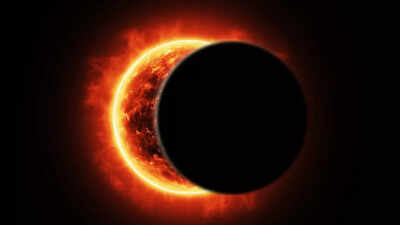ARTICLE AD BOX

As 2025 heads toward its end, a special sky event is on the way. On September 21, the Moon will move in front of the Sun, creating a partial solar eclipse. This means part of the Sun will look covered, giving people a rare chance to watch this cosmic event unfold.Understanding the partial solar eclipseA solar eclipse happens when the Moon moves between the Earth and the Sun, blocking some of the sunlight. In a partial eclipse, the Moon covers only part of the Sun, while in a total eclipse, the Sun is fully hidden. During this event, the eclipse will reach about 85% coverage, so in the best viewing spots, most of the Sun will look shaded.When to watch

The eclipse will take place late at night in Indian Standard Time, continuing into the early hours of September 22.
It is expected to begin at 10:59 PM IST on September 21, reach its peak at 1:11 AM IST on September 22, and end by 3:23 AM IST the same day. Since the Sun will be below the horizon during this time in India, the eclipse won’t be visible to viewers in the country.Best viewing locationsAccording to a report by India Today, the partial solar eclipse will be visible from many places in the Southern Hemisphere, including parts of Australia, New Zealand, several Pacific islands, and even Antarctica.
In Australia, people in Sydney, Canberra, Hobart, Lord Howe Island, and Macquarie Island will get to see it. In New Zealand, cities like Auckland, Wellington, Christchurch, and the Chatham Islands are included.

Across the Pacific Islands, the eclipse can be seen from Fiji (Lautoka, Nadi, Suva), Samoa (Apia), Tonga (Neiafu, Pangai, Nuku’alofa), American Samoa (Pago Pago), Niue (Alofi), French Polynesia (Vaitape, Papeete), Cook Islands (Rarotonga), and Vanuatu (Port Vila, Luganville).Even in Antarctica, research bases like Mario Zucchelli Station and McMurdo Station will get a clear view.For Australia and New Zealand, the eclipse will be at its peak during the early hours of September 22. Southern New Zealand will see the maximum coverage, reaching up to 86%. In Antarctica, the event will last the longest, giving scientists at the research stations more time to observe.

Concluding the year’s eclipse eventsThe partial solar eclipse on September 21 will be the last eclipse of 2025. Earlier this year, there was another partial solar eclipse in March, followed by two total lunar eclipses in September. For people in the viewing regions, this September event will be the final opportunity of the year to watch a slow and clear alignment of the Sun and Moon.Images: Canva (for representative purposes only)



.png)
.png)
.png)
















 1 hour ago
4
1 hour ago
4









 English (US) ·
English (US) ·